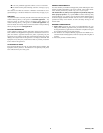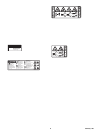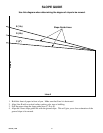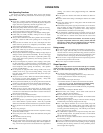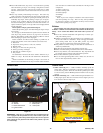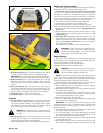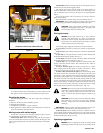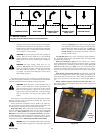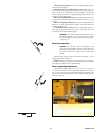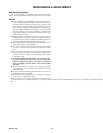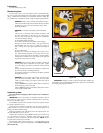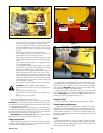
14 601156_1106
for a couple of minutes; then rotate ignition key counter-clockwise to the
OFF position. Remove the key from switch before leaving the tractor.
Stopping the engine
Use the following procedure to shut off the engine after operating the
equipment.
1. Place the control levers in the park brake position
2. Disengage the deck clutch
3. Throttle back to low idle for a couple of minutes
4. Rotate ignition key counter-clockwise to the OFF position. Remove the
key from switch before leaving the tractor.
Moving tractor with stalled engine
If it becomes necessary to move the tractor when the engine is inopera-
tive, the transaxles are equipped with bypass valves.
Mini FasTrak 36/42 - Before moving the unit, pull out on the bypass
valve rods and slide them into the slot to lock in position. Both bypass valve
rods are located underneath the rear of the tractor at the back of the transaxle.
(Fig. 3-5)
FasTrak 48/54 - Before moving the unit, pull up on the bypass valve rod
and slide it in the slot to the disengaged position.
The steering control levers must be placed in the neutral position, to
release the park brakes, so that the tractor can be moved. Both bypass valve
rods are located at the front corners of the engine on the engine platform.
Fig. 3-6
Do not tow the machine. Move it by hand or use a winch to load on a
trailer for transporting.
When transporting on another vehicle, the tractor must be secured.
IMPORTANT: Always make certain the two bypass valves are returned
to their operating position before running the tractor following repairs.
WARNING: Allow engine exhaust manifold to cool before
engaging or disengaging the bypass valves. The bypass valve
rods are located close to the exhaust system.
Driving the tractor
DANGER: Never make sudden stops or reverse direction,
especially when maneuvering on a slope. The steering is
designed for sensitive response. Rapid movement of the steer-
ing control levers in either direction could result in a reaction
of the tractor that can cause serious injury.
After starting engine, engage the control levers and steer as follows:
To go forward, push steering control levers forward an equal distance
(Fig. 3-7).
To go in reverse, pull steering control levers rearward an equal distance
(Fig. 3-7).
To turn left, move the right steering control lever farther forward from
neutral than the left steering control lever.(Fig. 3-7)
To turn right, move the left steering control lever farther forward from
neutral than the right steering control lever. (Fig. 3-7)
To pivot turn, move one steering control lever forward and the other
steering control lever back of neutral. This will allow the drive wheels to
counter-rotate. (Fig. 3-7)
To stop or decrease speed, move steering control levers to neutral.
When going forward pull back gently on steering control levers. When
going in reverse push forward gently on steering control levers.
To make a three point turn to the right, move the left steering control
lever farther forward from neutral than the right steering control lever and
start the turn. Next, pull back on the steering control levers until they are
past neutral and the machine starts to go rearward. Pull right steering control
lever farther rearward from neutral than the left steering control lever until
the rear of the machine has pivoted around. Then, push the steering control
levers forward until they are both past neutral and the machine starts to go
forward. Push the left steering control lever farther forward from neutral
than the right steering control lever and finish the turn. (Fig. 3-9)
DANGER: When moving in the rearward direction push for-
ward gently on steering control levers and avoid sudden move-
ment. Any sudden movement could cause the front of the
mower to come off of the ground resulting in possible loss of
control.
WARNING: Always be aware of what is behind the machine
before backing up. Do not mow in reverse unless absolutely
necessary. Always look down and behind before and while
backing up.
IMPORTANT: Rapid movement of steering control levers is not recom-
mended as damage to the hydraulic system components may occur.
To increase speed, increase steering control lever’s distance from neu-
tral. The farther forward steering control levers are from neutral, the faster
tractor will travel forward. The farther back steering control levers are from
neutral, the faster tractor will go in reverse.
Operating suggestions
DANGER: Prior to operating the tractor the operator should
be thoroughly familiar with the proper use and operation of the
Figure 3-5
Figure 3-6
Mini FasTrak 36/42
Bypass valve rod
(Left rod shown)
(Viewed from the rear left underneath side)
Slot
Bypass valve rod shown in towing position
Bypass valve rod
(Left rod shown)
FasTrak 48/54



